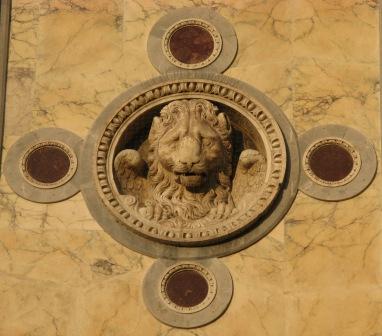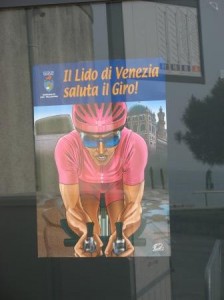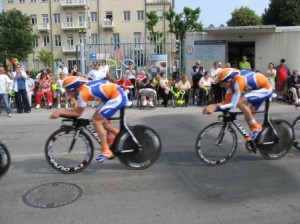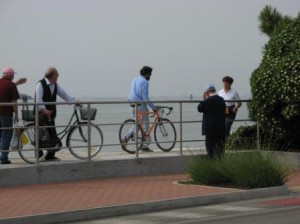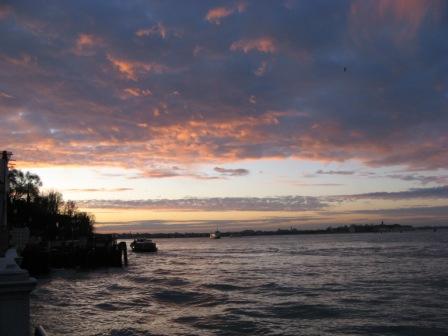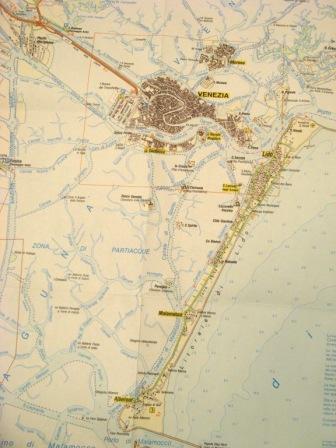The big present everybody got this year was acqua alta. It seems to have been reported fairly extensively in the world at large — not that people elsewhere don’t have enough drama of their own to keep up with — but there appears to be enough inherent drama, or diversion, in the phenomenon to attract attention.
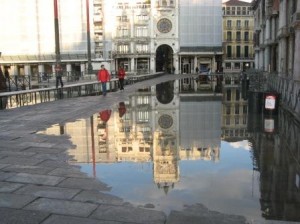
And they’re predicting more for today, New Year’s Eve, and also Day. Happily, these tides will peak at a decent hour, between 9:00 and 10:00 AM, so we can get some sleep. Thoughtful of them.
We spent most of Christmas Eve night listening, not for the reindeer hooves on the roof, but for the wind to veer around from the southeast to anywhere else it felt like going (or coming). But the forecasts (regular weather as well as high-water categories), which we consulted about every ten minutes, were implacable: There was going to be a strong scirocco (shih-RAWK-oh), and that meant that we were essentially destined to have “water on the ground,” as the Venetians call it in its more modest form.
The scirocco’s force pushes against the lagoon and prevents (or severely slows, but I’m going with prevents) the tide from going out in its normal way and even exacerbates the subsequent normal rising tide. The weather report specifies the direction and strength of the wind, but all we need to do is open the front door and listen: A strong scirocco causes heavy surf which in turn make a low, smooth roar, something like a distant jet preparing to taxi for take-off. And we can easily hear it, out there toward the left, where the Lido’s slim line of beach is doing what it can to keep the Adriatic where it belongs.

The city’s Tide Center was predicting that the maximum height, at 4:30 AM, Christmas Morning, would be 150 cm [59 inches, or almost five feet] above average sea level. I will explain the intricacies of these measurements and their meaning in the real world on another occasion, though let me just note here that Venice does not sit precisely at sea level, but at various heights above it, so these numbers are not immediately as dramatic as they sound.
As the Tide Center explains on its website, “97 percent of the city is at about 100 cm above the average sea level. This means that the amount of water that could invade the city is always well below the maximum number predicted. For example, an exceptional tide of 140 cm corresponds in reality to about 60 cm [23 inches] in the lowest points of the city (Piazza San Marco).”
I don’t know how high our domicile happens to sit above the average sea level, but we knew that at 150 cm there would be water coming over our top step and into our house. It’s just a little hovel, true, but it’s not a boat, unfortunately — not that you want water coming into your boat, either. Venice is an excellent place in which to discover the meaning of “time and tide wait for no man.” You can slow an avalanche pretty much as easily as you can slow the tide.
We knew our tidal limit because we had water in the house once before. Yes, that was one memorable moment. On December 1, 2008, we stood there at our doorstep and watched the water slip under our door — and more to the point, under the temporary barrier we had paid 400 euros for. But it wouldn’t have made any difference because only God and, perhaps, the architect has any idea what’s under our dwelling because water began to enter through a fissure in the kitchen wall, and then up from an ungrouted joint between the slabs of stone paving between the bedroom and the hallway. I can tell you that if the tide wants to come up through your floor you better just let it.

By the way, nothing was damaged, and when the tide turned about an hour and a half later, we got out our brooms and just swept it out to sea. Then I had to wash the floor with fresh water, but it needed it anyway. (I waxed it too — I was feeling like celebrating.) Then we put all the stuff that had been thrown onto the bed back under the bed, and life went on. No death, no damage, and as I say, the floor was clean. But you can’t count on high water being so relatively minor every time, and you really don’t want water, salt or otherwise, under your refrigerator and washing machine.
So at 2:00 AM on Christmas Eve (that is, Christmas morning) we got up and began preparing for the onslaught. No wailing, no hysterical vows to the Virgin; we just began to move whatever we could to higher ground (the bathroom) or on the bed. Last year, unbelieving to the last moment, we left everything where it was, which meant that Lino accomplished what ought to be an Olympic sport — the pulling-out-stuff-and-throwing-it-all-on-bed event — in mere seconds.
Then we took out candles and flashlights. I frittered away a little time sweeping and dusting, since I was going to have to do it anyway. We stared out the front door at the water. We listened.
But we were spared. Lino, whose instincts have been honed by an entire lifetime in boats in the lagoon, sensed when the reprieve was arriving — he could tell that the tide had slowed (“gotten tired,” as they put it) at about 3:30. The tide, in fact, did begin to turn then, earlier than predicted, and lower (143 cm) than predicted. The roar of the wind was diminishing. Christmas morning was beginning to look better than we’d supposed.

Turns out that this event was the fourth highest tide since the city began to record them. It also turns out — for real weather geeks — that one reason it occurred was not so much the force of the scirocco but the fact that it was constant for quite a while. In any case, nothing you can do about that; whatever the wind is doing, you just have to go along with it.
But I have to repeat what I always repeat when high tide makes the news: Nobody dies. Nothing gets especially damaged (I put in “especially” so somebody won’t say “Well what about my bookcase?”). The shopowners had to spend the night keeping vigil in their shops, which earned a few lines in the general coverage, but I say: So? We were up too and we don’t have anything we’re planning to sell. Water damage, whether it’s genuine or just labeled as such, is a great way for merchants to get rid of stock that isn’t moving anyway. I did not make that up.
Another point to consider: Whenever the news reports refer to the city being “under water,” or “flooded,” or however they term it, they never say how much of the city, nor do they say to what depth (it isn’t uniform; does one inch count as “flooded”?). Anyway, in the case of an exceptional high water, such as our Christmas Eve marvel, 56 percent of the city has water on the ground. Sound bad? Let’s do this: “44 percent of the city did not have water.” I suddenly feel better. Why don’t the newspapers ever do that? Rhetorical question.
So on to the next tide, I say, and pull out your cameras. But I think somebody should make it illegal to bring your boat into the Piazza San Marco, and doubly illegal to float around so people can snap your picture. The tide comes in, the tide goes out, all it leaves is some muddy slime
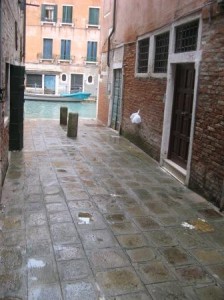
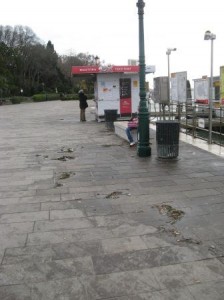
and bits of garbage tangled up in clumps of eelgrass and busted bits of reeds floating in from the barene, the marshy wetlands. This has been going on since the ocean was invented. If you really can’t stand it, go live somewhere more tranquil — say, Haiti in hurricane season, or Bangladesh when the typhoons come through. Or even certain parts of Tuscany the past few days, where some rivers have had nervous breakdowns under the unusually torrential rain. It’s just a suggestion.
So I’m going to stick with wishing everyone happy holidays. I’ll be back with more bulletins.
